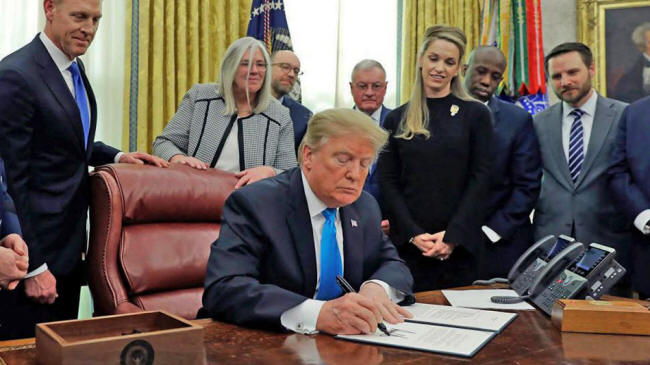What is the U.S. Space Force?
by
Jeremy Rehm
October
10, 2018
from
Space website
The United States Space Force is a newly proposed
military branch that President Donald Trump announced
during a meeting of the National Space Council on June 18, 2018.
If the proposal is
enacted, it will become the sixth armed forces branch, joining
the Navy, Army, Marine Corps, Air Force and Coast Guard.
Trump's announcement took many by surprise, especially in the
Pentagon. Some saw the sudden proposal as a strategy to compel
Congress and the Department of Defense into supporting a
military branch focused solely on space.
Others saw it as
answering the need to address the
growing rivalry and presence of
China and Russia in space.
"It is not merely
enough that we have American presence in space," Trump said
during his public proposal. "We must have American dominance
in space."
Vice President
Mike Pence officially unveiled the plans for the U.S. Space
Force a short two months later on Aug. 9, 2018.
So, what is
the Space Force?
As much as it sounds like
the Space Force will be
astronaut soldiers wielding blaster rifles, the reality is much
more mundane.
Rather than deploying
soldiers in space, the Space Force will focus on national
security and preserving the satellites and vehicles that are
dedicated to international communications and observation.
Immediately following Pence's announcement in August, the
Pentagon released a report that detailed some of the Department
of Defense's immediate actions for creating the Space Force:
-
Establish a
Space Development Agency – This is an agency tasked with
developing and testing new and improved
national-security capabilities and technology in space.
-
Establish a
Space Operations Force – This force will be a collection
of space experts from throughout the military who will
provide needed expertise to combat commanders and anyone
else throughout the Space Force.
-
Create a
United States Space Command – Led by a four-star general
or flag officer, the new space command would direct and
improve operations for space war fighting.
These three
components would later be united to become the final Space
Force.
Why is a
Space Force needed?
Russia and China are the U.S.'s two greatest space competitors
and also potential military threats. And both have
demonstrated formidable space capabilities.
In 2007, for example, China launched a missile that climbed
skyward for 500 miles until it impacted one of the country's own
defunct weather satellites, which rained down in thousands of
pieces.
In a similar
unnerving event in 2014, a piece of supposed Russian space junk
called Object 2014-E28 turned out to be an autonomous
robot of sorts that was capable of docking onto satellites.
During his August 2018 address, Pence said that China was
investing in hypersonic missiles capable of evading U.S.
detection. And both Russia and China had integrated
anti-satellite attacks as part of their wartime protocols.
Given that the U.S. government and military rely heavily on
satellites for,
...the threat became
obvious.
Does
something like this already exist?
China, Russia and the United States have military sectors
already dedicated to space. Russia revived the Russian Space
Forces in 2015 as a branch of the Russian Aerospace Forces.
In the same year,
China established the People's Liberation Army Strategic
Support Force as the space and cyberwarfare branch of the
People's Liberation Army.
The U.S. has the Air Force
Space Command, which is
integrated into the U.S. Air Force.
But many have argued
that an independent branch should be established to focus
exclusively on space.
"Whether it's a
Space Force or something else, it is absolutely critical to
have someone who thinks about this day and night," Terry
Virts, a retired NASA astronaut and former Air Force fighter
pilot, told SpaceNews.
Representative
Mike Rogers, R-Ala., first made such a proposal.
He called it the U.S.
Space Corps during the 2016 Space Symposium in Colorado Springs,
Colorado.
The proposal was eventually included as an amendment to the
House of Representatives 2018 National Defense Authorization
Act, which spelled out the Department of Defense's budget and
policies for the 2018 fiscal year.
The House passed the
bill with the amendment, but members of the Senate viewed the
amendment with skepticism and ultimately vetoed it.
Trump then commandeered the debate in June 2018 and announced
the administration would form the U.S. Space Force.
What's next?
Many details remain uncertain, such as how much a new military
branch would cost and whether Congress would ever fund it.
"It's hard to see
a scenario where the Space Force doesn't need a bunch of
additional money to not only fund the reorganization but
also all the new programs and capabilities," Brian Weeden, a
space policy expert at Secure World Foundation in
Washington, D.C., told Politico.
The White House
pushed for Congress to invest an initial $8 billion in national
security space systems over the next five years.
But creating an
entirely new branch of the military is expected to cost much
more. A leaked memo from the Air Force in mid-September shows
estimates of it requiring as much as $13 billion in its first
five years.
Because the program would also draw resources and a necessary
13,000 personnel away from other military branches, some fear it
would weaken the U.S. military overall.
The Pentagon, nevertheless, immediately got to work on laying
out the proposal.
Less than two months
later, in early August 2018, Pence announced that the new branch
would be established as soon as 2020.


